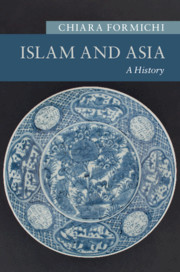Book contents
- Islam and Asia
- New Approaches to Asian History
- Islam and Asia
- Copyright page
- Dedication
- Contents
- Figures
- Maps
- Boxes
- Sources
- Preface
- Acknowledgments
- Note on Transliteration and Foreign Terms
- Maps
- Introduction
- 1 Islam across the Oxus (Seventh to Seventeenth Centuries)
- 2 Becoming Muslim (Seventh to Eighteenth Centuries)
- 3 Networks and Renewal (Thirteenth to Nineteenth Centuries)
- 4 Pan-Islamism and Nationalism (Nineteenth and Twentieth Centuries)
- 5 Muslims in the Nation-State (1940s to 1960s)
- 6 New Imaginations of Piety (1960s to 1990s)
- 7 Islam as Resistance
- 8 De-centering Islamic Authority
- 9 Studying Asia and Islam
- Glossary
- Notes
- Index
- New Approaches to Asian History
- References
8 - De-centering Islamic Authority
Published online by Cambridge University Press: 16 April 2020
- Islam and Asia
- New Approaches to Asian History
- Islam and Asia
- Copyright page
- Dedication
- Contents
- Figures
- Maps
- Boxes
- Sources
- Preface
- Acknowledgments
- Note on Transliteration and Foreign Terms
- Maps
- Introduction
- 1 Islam across the Oxus (Seventh to Seventeenth Centuries)
- 2 Becoming Muslim (Seventh to Eighteenth Centuries)
- 3 Networks and Renewal (Thirteenth to Nineteenth Centuries)
- 4 Pan-Islamism and Nationalism (Nineteenth and Twentieth Centuries)
- 5 Muslims in the Nation-State (1940s to 1960s)
- 6 New Imaginations of Piety (1960s to 1990s)
- 7 Islam as Resistance
- 8 De-centering Islamic Authority
- 9 Studying Asia and Islam
- Glossary
- Notes
- Index
- New Approaches to Asian History
- References
Summary
This chapter revolves around the emergence of new sites of authority as the outcome of very peculiar connections between upward mobility, consumption, state intervention, shifting gender norms, and concerns with piety in Southeast Asia, arguing that such combination and sequence of factors has allowed for the emergence of “religious authority” from the margins, in terms of geography, content, methods, and positionality, in Indonesia and Malaysia. This is illustrated with the cases of halal certification, modest fashion, and feminist juridical interpretation of the scriptures. The “sites” of authority here are not only innovative because they are the outcome of modern socio-political developments, but also because, through the deployment of new technologies, they have been elevated from “local” to “global” (or at least transnational), challenging discourses on religious authority that for centuries privileged the Arab “center” over Asian “peripheries,” ultimately positioning Southeast Asia’s Muslims as authoritative “pathfinders”.
Keywords
- Type
- Chapter
- Information
- Islam and AsiaA History, pp. 236 - 263Publisher: Cambridge University PressPrint publication year: 2020

